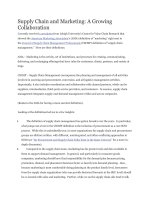supply chain and marketing
Bạn đang xem bản rút gọn của tài liệu. Xem và tải ngay bản đầy đủ của tài liệu tại đây (50.4 KB, 4 trang )
Supply Chain and Marketing: A Growing
Collaboration
I recently received a newsletter from Lehigh University’s Center for Value Chain Research that
showed the American Marketing Association’s (AMA) definition of “marketing” right next to
the Council of Supply Chain Management Professionals (CSCMP) definition of “supply chain
management.” Here are their definitions:
AMA – Marketing is the activity, set of institutions, and processes for creating, communicating,
delivering, and exchanging offerings that have value for customers, clients, partners, and society at
large.
CSCMP – Supply Chain Management encompasses the planning and management of all activities
involved in sourcing and procurement, conversion, and all logistics management activities.
Importantly, it also includes coordination and collaboration with channel partners, which can be
suppliers, intermediaries, third-party service providers, and customers. In essence, supply chain
management integrates supply-and-demand management within and across companies.
(Kudos to the AMA for having a more succinct definition).
Looking at the definitions led me to a few insights:
1. The definition of supply chain management has gotten broader over the years. In particular,
what jumps out at me in the CSCMP definition is the inclusion of procurement as a core SCM
process. While this is undoubtedly true, in most organizations the supply chain and procurement
groups are distinct entities, with different, nonintegrated, and often conflicting approaches to
SCM (see “Do Procurement and Supply Chain Folks Exist in the Same Universe” for a more in-
depth discussion).
2. Compared to the supply chain team, marketing has far greater tools and data available to
them to support demand management. In general, and particularly in consumer goods
companies, marketing should have final responsibility for the demand plan because pricing,
promotion, channel, and placement decisions factor so heavily into demand planning. Also,
because marketing is most comfortable doing planning at the product family level, forecasters
from the supply chain organization (who can provide historical forecasts at the SKU level) should
be co-located with sales and marketing. Further, while we on the supply chain side tend to talk
about sales and marketing as if they are on the same team, the chasm between sales and
marketing can be as wide as the gap between marketing/sales and operations.
3. Sales and Operations Planning (S&OP) is a proven process for integrating the sales,
marketing, and supply chain organizations. However, few companies have a robust S&OP
process in place. In contrast, companies are in the early stages of better integrating
merchandising and supply chain management processes. This is the next frontier for marketing-
to-supply chain collaboration (see “The First Moment of Truth”).
4. In the retail/consumer goods supply chain, large retailers are beginning to understand how
rationalizing the number of SKUs they carry can lead to both less cluttered, more customer
friendly stores, and to supply chain efficiencies, such as inventory reductions and gains in labor
productivity. This will lead to improved supply chain synergies between retailers and many of
their manufacturing suppliers. However, in some product categories, some vendors will actually
find their products are no longer needed (see “Walmart’s ‘Win-Play-Show’ Assortment Strategy”).
5. Internet retailing and e-fulfillment processes have gone through the hype, boom, and bust
stages and have finally ripened into a substantial and mature channel. This e-channel is
supported by mature processes and technologies, including online reservation systems, dynamic
routing, distributed order management, and product information management. All of this has
occurred in a little more than ten years. Amazon’s recent acquisition of Zappos, an online shoe
retailer, for almost $900 million dollars is a reminder of how far we have come in such a
relatively short period of time.
In light of these trends, what is interesting to me is that supply chain organizations seem to be
collaborating more with the marketing team than with their procurement colleagues. This is my
viewpoint—do you agree?
Marketing is focused on volume (evaluation and bonus metrics). Procurement, manufacturing, and
distribution are focused on cost containment (evaluation and bonus metrics). The CEO is being
judged in the boardroom and on “The Street” by the profit numbers. And supply chain management
is caught squarely in the crossfire of warring spreadsheets, a process that repeats itself every month
when marketing and manufacturing square off in the sales and operations planning (S&OP) meeting
to reconcile their differences. In essence, no one talks to each other.
INSIGHT’s (www.insightoutsmart.com) president, Jeff Karrenbauer, is a veteran of the supply chain
industry and has been evangelizing recently about the integration of supply chain plans with
marketing departments:
Strategic planning for supply chain and marketing too often proceed independently, that is, within
their respective silos. Even when forecasts are prepared collaboratively or a formal sales and
operations planning (S&OP) process is used (and most companies have not reached this level of
sophistication), the typical response of supply chain managers is reactive: verify adequate capacity
(procurement, manufacturing, warehousing, transportation), certify that service commitments can
be met, and approve the plan. The marketers smile — the supply chain costs are not in their
budget — and senior management approves the plan. The spreadsheets are in agreement!
This classic myopic approach suffers from a major shortcoming. There is no guarantee that resources
are being focused so as to maximize corporate financial objectives such as return on investment or
shareholder value. For example, assume for the moment that new marketing initiatives will
successfully stimulate demand. Perhaps that demand cannot be satisfied without major capital
investment which, in turn, negates the benefits. Or perhaps the effort is wrongly directed to markets,
channels, or products, whose margins, from a total supply chain perspective, are inferior or even
negative.
For many decades the silo approach has also been accepted for strategic supply chain design analyses
as well. Even when analysts employ sophisticated, optimization-based mathematical models,
historical or forecasted demand is still assumed to be given for any planning scenario. Alternative
demand assumptions require separate exercises. The supply chain, including procurement,
manufacturing, warehousing, transportation, inventory, duties, and taxes, is configured in response
to the fixed demand. The classic objective is to determine the optimal set of facilities and flows so as
to satisfy demand and minimize cost, subject to all capacity limitations and service requirements.
There is no consideration given to simultaneously choosing an optimal level of demand.
For the first time in history there is now a much better way. The fundamental change to the
traditional approach is to discard the assumption of fixed demand. In its place is a base level of
demand (historical or forecast), together with a series of proposed marketing initiatives, or
campaigns. Each such campaign is described by a budget (fixed and variable cost components),
budget limits (both min and max), and demand response curves that relate marketing expenditures
to changes in demand. The model is now charged with simultaneously optimizing marketing and
supply chain expenditures so as to maximize margin and total profit. To do so it must select
campaigns that result in a level of demand that can be met by the supply chain. Given that
requirement, it directs the marketing expenditures to those markets, channels, and products with the
greatest margin, thereby maximizing profit. In doing so, it avoids the common strategic planning
mistakes described above. In short, the strategic planning objective is completely aligned with the
senior executive suite: simultaneously balance all corporate resources so as to maximize profitability
and return on shareholder equity.








